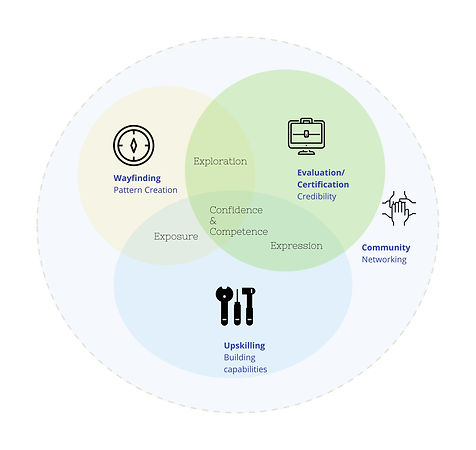Loom
Post-pandemic education system


Extending and Expanding Educations Impact in the Global Village
tag: Strategic planning, social design, systematic thinking
Loom is a system weaving education and community together. The goal of this project is to gain insights and strategic drivers to build a platform to solve the teenagers' disengagement problem in the existing education system after the pandemic.
time: 2021 summer
Background
From 2020, a widespread global pandemic interrupted people's life. Many cities were locked down, people were asked to stay at home to reduce the risk of getting infected or further spreading the pandemic. During this time, various problems occurred and people accommodated themselves in different ways to handle this new challenge. Harvard School of Public Health conducted an ethnographic study to gather data about how people in different parts of the world are coping with the COVID-19. From that, we did a series of ideation to analyze the data and to explore how organizations, services, and strategies could help to build better learning conditions in such a turbulent world.
The Approach
Whole View model

— MY ROLE
Design Researcher, Strategist, Storyteller
— COLLABORATORS
Zack Schwartz
Veronica Paz Soldan
Mrinali Gokani
— COURSE DETAILS
Whole Life: Designing Life After Covid-19
André Nogueira, Co-Founder
Associate Researcher & Instructor
Harvard T.H. Chan School of Public Health
Our Project
What's the problem
Teenager disengagements in pandemic schooling
The world was locking down and the schools were shut down too. Many teachers and students had to adjust to new phenomena of remote learning and many found it difficult to engage. Some students also had issues accessing the technology for online classes, which made them even harder to get support for their education.
" One of the biggest things we have to worry about for this particular generation is disengagement. We have to work out clever and creative ways to continually keep young people engage. We can't just stick to what we did in the past"
- Nicholas Wyman Founder CEO
(Institute for Workplace Skills & Innovation)

Insights from the primary research
-
Teenagers are the most vulnerable group to handle the crisis.
-
Teenagers critical moment of learning how to be independent, first jobs, first major responsibilities, first key life decisions
How might we provide an environment helps to cultivate cognitive resilience for future generations?
What is the current state of schooling?
From conductor to curator

Current system
Scholastic institutions have long been centralized entities that have prioritized assembly line-like instruction awarding mastery through standardized pedagogy.

Proposed system
Repositioning schools to the outer ring of the stakeholder map enables schools to have a radically different role of schools as facilitators of flexible, experientially driven networks that are relevant and adaptive to student & community needs

What is it?
Loom weaves together community and learning
What is it?
Loom weaves together community and learning
What does it do?
to increase learner agency, engagement and community accountability through a combination of modern apprenticeship and integration of life skills
What's the impact?
so that teenagers and communities can develop a higher level of competence and confidence to thrive in an increasingly disruptive world

User Case

John

Maria

Our Solution




Value added
Individual level
New interventions
Organizational level
New services
Community level
New opportunities
Offerings

Wayfinding
Pattern Creation
Upskilling
Building capabilities
Evaluation/ Certification
Credibility
Community
Networking
Identify needs, gaps of learning journeys of community
Provide visualization and guidance as to potential paths, collaborations, and impacts of choices.
Provide flexible learning modules and guidance to ensure everyone has what they need to weave the best educational experience for the teenagers.
Provide a framework for critique, evaluation, and certification that helps validate community skills, capabilities.
Ensure accountability and generate trust and progress among all.
Facilitates the interaction and building of the community that can support teenagers as well as lifelong education. Safe space to learn key skills of networking as well as access to a variety of support.
Impact and reflection

Impact
The Loom Learning Experience works as a plus-one component to the existing system, which doesn't require the entire remodeling of the current schools. It acts as an optional add-on module to encourage teenagers to gain life-long value through the connection with local communities.
As we all know people are a product of their environment. By investing our time and focus into the community, the impact of these efforts will soon be felt and paid back to the community members.
For local business owners and collaborators, it would also increase their social impact and build connections to the younger generations and their families.
Reflection
When designing a product, most of the time we would apply the human-centered design approach and focus on the users. However, the world is interconnected between different systems. When dealing with social issues, it is inevitable to see how other agents would affect the result and we would easily lose focus when there are a lot of factors. The Whole View model provides a great structure for us to zoom in and out the problem but still stay on track.
I, like many others, was also heavily impacted by this challenge, however using this systematic thinking and Whole View model I have found that I have a deep passion for education and community enhancement.
